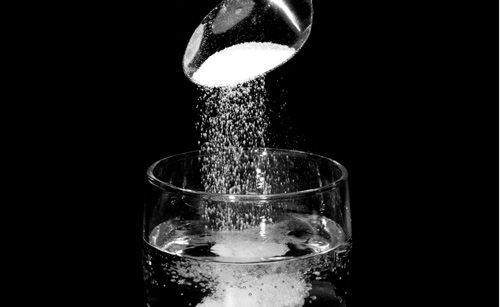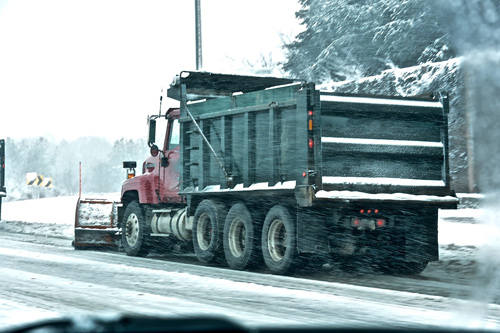Winter is here, which means it’s only a matter of time before snow and ice begin to cover highways, streets, and backroads. Salt trucks can be seen lining the roadways waiting to combat the winter weather with layers of salt.
Salt, otherwise known as sodium chloride, is effective when it comes to melting snow and ice. Its effectiveness is due in part to its ability to lower the freezing temperature of water. This happens because the sodium ions and chloride ions prevent the water molecules from bonding to create ice.
How Salt Dissolves

Water is a universal solvent because it dissolves more substances than other liquids. One substance this applies to is sodium chloride—aka salt. When you mix salt and water together, the salt molecules detach and reattach themselves to the water molecules, thus creating an electrolyte solution.
The positive ions from the salt gravitate to the negative ions in the water molecules. This creates a disruption in the molecular structure, and the free ions are left suspended in the water. A scenario such as this one happens when you put road salt on an icy road. The molecules keeping the water freezing, are torn apart, making the ice melt.
The Negative Effects of Salt on the Environment
In 2015, it was discovered the water supply in Flint, Michigan was polluted with high levels of lead due to excessive chloride levels lining the city’s plumbing. The chloride levels were caused by road salt. Unfortunately, once salt is introduced into a water supply, it can be difficult to completely remove it from the water system. It has become such an issue in the United States, that increasing levels of salt are being found in bodies of fresh water.
This infiltration in freshwater ecosystems is damaging to water species and their living spaces, reproduction rates, and food availability. When road salt is washed off the road by rain or other sources of liquid, it can decrease oxygen levels in the water it flows into, which also negatively impacts aquatic creatures.
As you can see, road salt will stay in a region’s watershed for decades, damaging life the longer it stays. It has been proven that most of the chloride found in these regions is from the storage and application of road salt we use to deice our roadways. Not only is this damaging the environment, but it is also harmful to us if we consume these high levels of chloride. One way you may be able to notice an increase of chloride in your drinking water is if your water tastes salty.
When you take your water to Atlantic Blue Water Center for a free water test, we may suggest getting a reverse osmosis system to reduce the salt levels in your water. A GENRO, TFCRO, or ABRO reverse osmosis system is great for those who live near highly salty waters.
Contact Us
How Road Salt Impacts Your Health

Americans typically consume 4,000-6,000 mg of sodium per day, while those on a reduced sodium diet consume 1,000-3,000 mg per day. Salt is naturally in water, and it’s normal for a person to get some of their sodium from their drinking water.
However, in a 2008 study, it was discovered that the water in Dutchess County, New York had 347 mg of sodium per liter of water. In other words, people consuming up to 2 liters of water per day in this county would ultimately consume upwards of 700 mg of sodium. These dangerous levels of salt can contribute to serious conditions like hypertension which can be dangerous for those on a low sodium diet.
The increase in sodium in New York was caused by the use of road salt during the harsh winters in New York. Since salt is difficult to remove from groundwater, it will continue to increase over the time, even if we were to stop using salt as a deicer. While you may think that water softeners and sewage add to salt increase in water, road salt is responsible for up to 90% of the salt found in water.
How to Reduce the Effects of Road Salt
Everyone can do their part in reducing road salt use and preventing further damage. By following these guidelines, you will not only help the environment, but you will also save money.
- If you are using rock salt, use a handful per square yard. If you are using calcium chloride, use a handful per 3 square yards.
- Shovel and clear snow as often as you can. This will help prevent the snow from freezing overnight, turning it to ice.
- The more frequently you remove ice from roadways, driveways, and sidewalks, the less salt you will need.
- When the temperature gets warmer, be sure to remove the slush created by the mixture of ice and salt so it does not freeze again.
- Plant salt-tolerant trees and plants that can catch some of the run-off before it reaches bodies of water, roads, animal habitats, and more.
- Keep salt away from water areas like wells as this could cause salt to enter your drinking water.
- Most importantly, do not use deicer if there is not an imminent storm. If you do happen to use a deicer to prepare for a storm that does not occur, sweep up the deicer to save it for later.
Have Your Water Tested By Atlantic Blue Water Center
Atlantic Blue Water Center will conduct a free water test and provide you with effective solutions to improve your water. Call our specialists today at (410) 840-BLUE (2583) or toll-free at (866) 380-BLUE (2583) to have the pure water you deserve!
